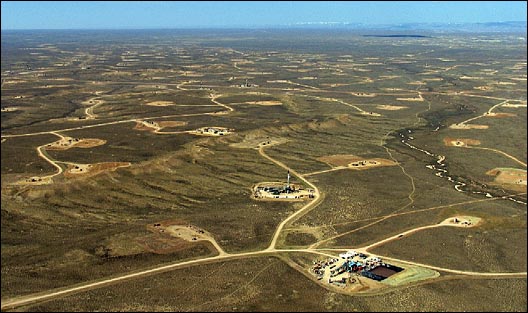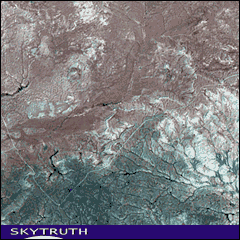
John Amos.
With what environmental organization are you affiliated?
I’m president of SkyTruth, a nonprofit I founded in 2001.
What does your organization do?
SkyTruth puts into practice that old cliché, “A picture is worth a thousand words.” We use photos of the earth taken from orbiting satellites and airplanes to help people see — and feel — for themselves how we’re changing our planet. In geek-speak, our expertise is in remote sensing and GIS (Geographic Information Systems): processing and analyzing digital images, and creating media-friendly graphics, maps, and scientifically useful data from those images. We understand how these tools can be used to study and illustrate environmental issues. We work with many small NGOs that just don’t have the resources to harness this dynamic technology.

What are you working on at the moment?
Our main focus, mostly springing from my experience as a commercial geologist, has been illustrating the rapid spread of natural-gas drilling in the Rockies, and the impacts of gold mining around the world. Right now we’re working on the drilling going on in Wyoming’s Green River Valley; on a huge open-pit gold mine that’s been proposed in the pristine Bristol Bay watershed of Alaska (the Pebble mine); and, closer to home for me, on the widespread disruption caused by mountaintop-removal mining for coal in West Virginia.
We’re also harnessing Google Earth and other “virtual globes” as a very fun way to interact with the images we produce. We’re in the middle of a revolutionary leap forward in environmental communication.
How do you get to work?
It’s a very low-carbon commute! I walk from the dining room up the stairs to my office. Occasionally I take the train into D.C. for meetings.
What long and winding road led you to your current position?
I’ve always loved the outdoors and wildlife, and wanted to know how the landscape around me came into being. That created a logical progression in my life: from avid reader of Ranger Rick, to Eagle Scout, to student of geology. And then to husband of Amy, a dedicated environmental advocate: we shared that deep-rooted affinity for wildlife and wilderness.
Ultimately I became a professional geologist: working as an exploration consultant for oil and gas and mining companies. At first it was fun to see the world, virtually, with satellite images. But over the years I became less and less satisfied with how I was spending my time and energy. Those fascinating images displayed unambiguous signs of human-caused destruction: oil slicks in the oceans, forest reserves being chewed away by logging on all sides, mines causing perpetual pollution of lakes and streams, oil and gas drilling spreading inexorably across vast areas of public land. And I couldn’t ignore the fact that I was contributing to this both personally and professionally.
Finally, I saw two satellite images that changed my life. One was an image of the area around Mount St. Helens taken several years after the eruption. It clearly showed the forested area devastated by the blast. But there was something else, something the public hadn’t been shown on the TV news: the blast damage was insignificant compared to the clear-cut logging in every direction. When it came to destruction, we had beat Mother Nature hands down, but that was the Forest Service’s dirty little secret: you can’t see those clear-cuts from the highway.
The other was an image of the booming Jonah natural-gas field in western Wyoming. The drilling is almost all on public lands overseen by the U.S. Bureau of Land Management. Like most Americans, I thought energy development on public land was subject to stringent regulations. As a consulting geologist I knew there were a lot of economically viable and proven techniques that could greatly reduce the impact.

Jonah Natural Gas Field, upper Green River valley, Wyoming, as photographed in 1986, 2001, and 2005.
The BLM and oil industry missed no opportunity to suggest that these techniques were being routinely used, and that environmental damage was minimized. But the “footprint” of this drilling — three- to four-acre parking lots bulldozed into the rangeland for each well, connected with miles of access roads and pipelines and power lines — looked just like the bad old days of heavy impact. And when I started to ask questions, my colleagues confirmed that most of this drilling was being done the old-fashioned way: it was cheaper, and the BLM didn’t object. The companies working in Jonah crow to Wall Street about the huge profits they’re making. We were all being fed a line of BS while public lands were being needlessly damaged and wildlife was demonstrably being hurt. As a professional working for that industry, it really made me angry.
These images had important stories to tell, and the public needed to see them. That’s when I decided to start SkyTruth.
Where were you born? Where do you live now?
I was born in Rochester, N.Y. After a too-short time in Wyoming, and 15 years in Arlington, Va., Amy and I moved to Shepherdstown, W.V. It’s a groovy little town on the Potomac River about 70 miles upstream from Washington, D.C.
What has been the worst moment in your professional life to date?
I’ve been lucky. The worst moment I had was at the end of a meeting with a program officer from a large Bay Area foundation, when he announced that SkyTruth’s business plan looked to him like just another dot-com from the 1990s. That was five years ago and we’ve thrived, so I get to laugh at that now!
What’s been the best?
There have been a lot of great moments since I started SkyTruth: giving up my commercial consulting work; the tremendous support from Amy, especially during those first years; attracting phenomenal board members and volunteers; the confidence boost of getting those first grants from foundations, and the real validation of getting repeat grants; knowing at the end of each day that I did something good. But I think the best moment was when a community organizer told me that SkyTruth images of the proposed Pebble gold mine changed the minds of a dozen Native Alaskan community leaders from being pro-mining to being uniformly opposed. Then I knew for sure that we had launched something very powerful.
What environmental offense has infuriated you the most?
The inaction of our government in the face of global warming. And I blame both parties for this. Even if the science all turns out to be wrong — not very likely — the actions we should be taking now are more than worth doing on their own merits: reducing pollution and increasing public health, saving land and forests and wildlife from destruction, improving energy efficiency to make American businesses more competitive in the global economy, freeing our foreign policy by reducing our dependence on fossil fuels. This really is not rocket science.
Who is your environmental hero?
My environmental heroes are everyone working for conservation at the grassroots level, in communities around the world. They face hardships every day: being ostracized by their neighbors and harassed by local authorities, working long hours with scant resources. These are smart, tough people, who could simply choose to go with the flow, to make money, to conform like everyone else. But I thank God that they don’t. Anything SkyTruth can do to help them in their work makes me feel like I’m doing something useful.
What’s your environmental vice?
Like any middle-class American, I use a lot of energy: I travel, and not by horseback; I eat fresh fruit in the winter that comes a long way to get to my table.
How do you spend your free time (if you have any)?
If you want to be in conservation for the long haul, you’ve got to stay fightin’ trim. I’m a fanatical cyclist in the summer, and love to hike in the winter. Whenever I travel, I take the time to get out into nature somehow, to keep my feet on the ground and revisit the source of my inspiration. Birding and bodyboarding are other seasonal obsessions. Indoors, nothing beats a great meal, great wine, and great company at the table.
Read any good books lately?
I just finished a great one: Small Wonder by Barbara Kingsolver. For me, she gracefully hits the nail on the head in so many ways that I can’t articulate. On deck: Jimmy Buffett’s Tales from Margaritaville.
What’s your favorite meal?
Wild Alaskan salmon, grilled with a light teriyaki glaze. Roasted vegetables, crusty bread, and a bottle of pinot gris from Oregon. Key lime pie to finish it off!
Which stereotype about environmentalists most fits you?
I wear boring shoes.
What’s your favorite place or ecosystem?
Home is my favorite place. But the high open plains of Wyoming make me thank God out loud for this life.
If you could institute by fiat one environmental reform, what would it be?
Charge a tax on all industrial emissions to our air, land, and water, including greenhouse gases. No more free passes for industry; no more free passes for us consumers, since we’ll ultimately pay that cost. Who knows what conservation benefits will emerge, at every level of society, when the incentive is there to spur innovation in the ways we make, use, and dispose of things?
Who was your favorite musical artist when you were 18? How about now?
18: Jimi Hendrix. 43: Emmylou Harris. With an occasional guest appearance by Jimi.
What’s your favorite movie?
Joe Versus the Volcano, The Year of Living Dangerously, Repo Man, and Blade Runner. And, I must admit, It’s a Wonderful Life. I always cry during that last scene and I’ve seen the damned thing about a million times.
Which actor would play you in the story of your life?
John Amos, of course (remember Good Times?). But if he’s not available, Owen Wilson might be up to it.
If you could have every InterActivist reader do one thing, what would it be?
How about two things?
First, volunteer for SkyTruth! We have loads of projects to do and a movement to build.
Second, adopt a place. A natural place, be it a stream, community garden, wilderness area, coral reef, or a spot on the map only you know about. Take action to protect that place: write to Congress, join an organization (or start your own), pick up the trash, pull out the invasives. Roll up your sleeves, get your fingernails dirty, make connections. Take ownership. Everybody can do something. And if everybody does do something, we’ll have a much brighter future.

